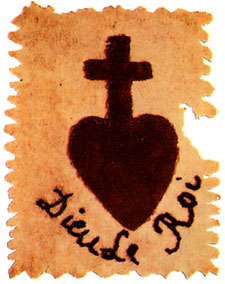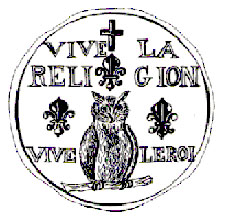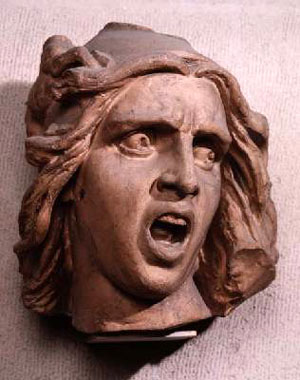 |
World History
The Suffering of Father Bardeau
Elaine Jordan
This story of the heroism of Father Bardeau gives a small idea of the real hatred of the French Revolution for the Catholic Religion. Smoldering under the brave call for Liberty, Fraternity and Equality was a desire to destroy the sublime and hierarchical order established in Christendom by the Catholic Church. Hence comes its hatred for our holy religion.

Insignas of the counter-revolutionaries: Above, a badge with the Sacred Heart and the words God and King; below, the chouan (owl) with the words Vive Religion! and Vive the King!
 |
Father Bardeau was one of those who followed the troops of the Chouans, the royalists in France, especially in Bretagne, who fought against the French Revolution. They took their name from the nickname of one of their Breton leaders, Jean Cottereau, who was accustomed to warn his companions of danger by imitating the chouan (screech owl). It was the men of the Vendée and Bretagne who made the strongest resistance against the revolutionaries. The peasants of these regions rose up to fight for the Church and the Catholic monarchy.
During the Reign of Terror when the revolutionary troops would enter a town, whole populations would flee to escape the slaughter, for the order from Paris was peremptory: “"Kill them all to the last man, woman and child. That is your duty.”
It was during this terrible time that one early morning, the Father was celebrating Mass for about 50 men, women and children in an abandoned barn in the countryside. Confident that they were well-protected, all were recollected in prayer. Since all planned to go to Communion, there were a good number of consecrated hosts.
Communion had just begun when the “surprise” came. Behind the high window, the revolutionaries were lying in ambush. Earlier, they had surprised and taken the sentinels, who were stiff with the morning cold, and had surrounded the farmstead, taking advantage of the singing of hymns, which covered the noise, to advance. The revolutionaries planned to fire on the group assisting at Mass during Communion, when the Bretons would be most recollected and least prepared for an attack.
The priest heard a noise that made him raise his eyes. Directly above a kind of skylight that had been stuffed with hay over the door, there was a movement. The hay fell, and a long barrel of a rifle appeared. There was no time to shout “To arms!” The slaughter began.
It was a most shocking and complete slaughter, one that the revolutionaries would congratulate themselves on later. No one escaped, with the exception of Father Bardeau.
After firing many rounds into the room, making the air thick with smoke and blinding the congregants, the revolutionaries forced the survivors to file out one by one to execute them mercilessly outside. They reserved the priest for last.
Father Bardeau tried to consume the Hosts left in the chalice, but two men grabbed him and held him tight. One of them took the ciborium and smiling, emptied it into the pigsty next to the barn onto the filthy ground of whey, mud and excrement.

The hatred appears on this head symbolizing La Marseillaise, the French revolutionary hymn |
“Since you wish to eat your good gods, go get them,” the soldiers said, laughing and mocking him.
On his knees before the sentinel, Father Bardeau extended his right hand to reach for a Host. A saber stroke cut off two if his fingers, leaving them on the fence rail. He extended his other hand. The saber cut through his palm. The soldiers laughed uproariously.
The Father squeezed his hands behind his back to try to stop the flow of blood, which was streaming from both hands. Then, on his knees, he leaned over and tried to catch between his lips the sacred white Hosts that were floating in the grime.
That was too much for the sentinels, and they fell upon the holy man. Some beat him with the butts of their rifles, others with their heavy military boots. Finally, they buried his head in the mud and left him for dead.
“I acted as if I were dead,” he confessed later, a little ashamed of the deceit. “They left me there in the mud…”
Once he was alone, he thrust the stubs of his hands into the putrid depths of the grimy mud to save his blood and strength.
The men of the Vendee found him an hour later, licking the grimy mud to pick up the Hosts and butting his head to fend the pigs off them.
The Father was tough and survived his ordeal. He stands as a symbol of the French counter-revolution in its sublime obstinacy.

As described by Jean de la Varenne in Homme D’Ars
Posted November 8, 2007

Related Topics of Interest
 Unmasking the Formidable Mythabout Queen Marie Antoinette Unmasking the Formidable Mythabout Queen Marie Antoinette
 Revolution and Counter-Revolution - Overview Revolution and Counter-Revolution - Overview
 Pope Bows to Ideals of the French Revolution Pope Bows to Ideals of the French Revolution
 Liberals, Modernists and Progressivists Liberals, Modernists and Progressivists
 St. Louis de Montfort St. Louis de Montfort
 Papal Knighthood Given to a Jewish Rabbi Papal Knighthood Given to a Jewish Rabbi
 Vocations of the European Peoples Vocations of the European Peoples

|
History | Home | Books | CDs | Search | Contact Us | Donate

© 2002- Tradition in Action, Inc. All Rights Reserved
|
 |
|